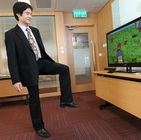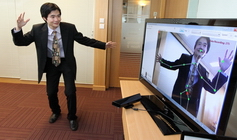|
|
|
|
|
|
|
KineLabs – body motion rehabilitation games train motor skills of stroke patients and enhance recovery |
|||||||
|
KineLabs – body motion rehabilitation games train motor skills of stroke patients and enhance recovery
|
Stroke patients are often required to perform repeated body movements to facilitate the rehabilitation programme. In this issue, PolyU Associate Professor in the field of Biomedical Engineering Dr Raymond Tong Kai-yu will share with us how to develop a series of body motion games and integrate them into the rehabilitation exercises after stroke. Stroke patients can then enjoy the fun games for upper limb and lower limb training in a 3D virtual environment while improving their reaction and motor skills on the way to recovery. 1/ What is the difference between your team’s newly developed 3D computer body motion games and conventional physiotherapy? Conventional physiotherapy often requires patients to repeat monotonous body movements. On the other hand, our series of 3D computer body motion games is fun-filled with a local flavour for people after stroke to exercise their upper and lower limbs for daily activities. The games included making egg tarts, cleaning window panes of a tram and killing cockroaches. Recently, this computer body motion games software won a Silver Award in the Hong Kong ICT Awards 2012: Best Innovation and Research Award. 2/ How can kinetic games be integrated into stroke rehab therapy to enhance the effectiveness of treatment? We have developed the “KineLabs” software platform and used a Kinect sensor to capture depth data for reforming the body skeleton and track down the precise movement for all the body joints. Users are required to move their upper and lower limbs to the extent of meeting the pre-set body motion. The system can also record and generate reports on the success rates and response time of performing different tasks, thus monitoring the progress of stroke rehabilitation. 3/ What are the benefits of playing these KineLabs games to stroke patients? Kinetic games can help the stroke patients who suffered from motor disabilities after stroke. Kinetic games can help train their balance, reaction and hands coordination, thus enhance their quality of life. They can also play KineLabs games at home, in hospitals and elderly centres as a kind of exercise training. 4/ How to install the rehabilitation games of the “KineLabs” software platform?
|
||||||


